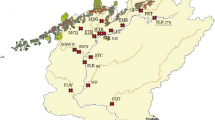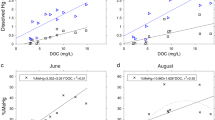Abstract
A 125-mile reach of the South River, Virginia, was contaminated with mercury during the first half of the 20th century. As increased concentrations of mercury have persisted, researchers have carefully studied its distribution in the river biota and estimated associated risks. The present study evaluated the influence of mercury on feeding rate and uptake by the amphipod Hyalella azteca. The test organisms were exposed for 7 days with leaf discs to reference and contaminated field sediment during the preliminary experiment and additionally to Sedimite (a commercial mercury-sequestering agent) amended sediments during the final experiment. The preliminary experiment demonstrated a decreased feeding rate (approximately 35%) of H. azteca in sediment from a contaminated site relative to sediment from a reference site. The test design of the final experiment took advantage of the knowledge gained in the preliminary experiment by increasing the number of replicates, which decreased the type II error rate. First, the results of the final experiment confirmed the results of the preliminary experiment by again demonstrating differences in the feeding rate of approximately 35% between reference and contaminated sediment. Second, the results indicated a lower feeding rate in reference sediment in the presence of Sedimite. Third, an opposite tendency, although not significant, was apparent for Sedimite-amended contaminated sediment. Thus, Sedimite appears to decrease sediment quality, whereas this conclusion is based on the feeding rate of H. azteca. However, Sedimite and its value as a mercury-sequestering agent requires further evaluation.




Similar content being viewed by others
References
Altman DG, Machin D, Bryant TN, Gardner MJ (2000) Statistics with confidence, 2nd ed. Br Med J Books
Baun A, Hartmann NB, Grieger K, Kusk KO (2008a) Ecotoxicity of engineered nanoparticles to aquatic invertebrates: a brief review and recommendations for future toxicity testing. Ecotoxicology 17:387–395
Baun A, Sorensen SN, Rasmussen RF, Hartmann NB, Koch CB (2008b) Toxicity and bioaccumulation of xenobiotic organic compounds in the presence of aqueous suspensions of aggregates of nano-C-60. Aquat Toxicol 86:379–387
Bergeron CM, Husak JF, Unrine JM, Romanek CS, Hopkins WA (2007) Influence of feeding ecology on blood mercury concentrations in four species of turtles. Environ Toxicol Chem 26:1733–1741
Borgmann U, Norwood WP (1997a) Assessing the toxicity of lead in sediments to Hyalella azteca: the significance of bioaccumulation and dissolved metal. Can J Fish Aquat Sci 56:1494–1503
Borgmann U, Norwood WP (1997b) Toxicity and accumulation of zinc and copper in Hyalella azteca exposed to metal-spiked sediments. Can J Fish Aquat Sci 54:1046–1054
Borgmann U, Norwood WP, Clarke C (1993) Accumulation, regulation and toxicity of copper, zinc, lead and mercury in Hyalella azteca. Hydrobiologia 259:79–89
Bousfield EI (1958) Fresh-water amphipod crustaceans of glaciated North America. Can Field Nat 72:55–113
Bundschuh M, Zubrod JP, Schulz R (submitted) The functional and physiological status of Gammarus fossarum (Crustacea; Amphipoda) exposed to secondary treated wastewater. Environ Pollut
Carter LJ (1977) Chemical plants leave unexpected legacy for two Virginia rivers. Science 198:1015–1020
DiStefano J (2004) A confidence interval approach to data analysis. For Ecol Manag 187:173–183
Gorski PR, Cleckner LB, Hurley JP, Sierszen ME, Armstrong DE (2003) Factors affecting enhanced mercury bioaccumulation in inland lakes of Isle Royal National Park, USA. Sci Total Environ 304:327–348
Hargrave BT (1970) The utilization of benthic microflora by Hyalella azteca (Amphipoda). J Anim Ecol 39:427–437
Hargrave BT (1972) Prediction of egestion by the deposit-feeding amphipod Hyalella azteca. Oikos 23:116–124
Helsel DR (2005) More than obvious: Better methods for interpreting nondetect data. Environ Sci Technol 39:419A–423A
Kemble NE, Hardesty DG, Ingersoll CG, Johnson BT, Dwyer FJ, MacDonald DD (2000) An evaluation of the toxicity of contaminated sediments from Waukegan Harbor, Illinois, following remediation. Arch Environ Contam Toxicol 39:452–461
Lawrence AL, Mason RP (2001) Factors controlling the bioaccumulation of mercury and methylmercury by the estuarine amphipod Leptocheirus plumulosus. Environ Pollut 111:217–231
Lee L (2009) NADA: Nondetects and data analysis for environmental data. R package version 1.5-2. Available at: http://CRAN.R-project.org/package=NADA. Accessed 18 March 2010
Lemon J, Bolker B, Oom S, Klein E, Rowlingson B, Wickham H, et al. (2009) Plotrix: Various plotting functions. R package version 2.7-2. Available at: http://CRAN.R-project.org/package=plotrix. Accessed 21 March 2010
Maltby L, Clayton SA, Yu H, McLoughlin N, Wood RM, Yin D (2000) Using single-species toxicity tests, community-level response and toxicity identification evaluations to investigate effluent impacts. Environ Toxicol Chem 19:151–157
Maltby L, Clayton SA, Wood RM, McLoughlin N (2002) Evaluation of the Gammarus pulex in situ feeding assay as a biomonitor of water quality: robustness, responsiveness and relevance. Environ Toxicol Chem 21:361–368
Menzie CA (2010) Combining engineering and biology in a low-impact in situ treatment system for sediments: Application to mercury. Available at: http://www.menziecura.com/. Accessed 28 September 2009
Mergler D, Anderson HA, Hing Man Chan L, Mahaffey KR, Murray M, Sakamoto M et al (2007) Methylmercury exposure and health effects in humans: a worldwide concern. Ambio 36:3–11
Nakagawa S, Cuthill IC (2007) Effect size, confidence interval and statistical significance: a practical guide for biologists. Biol Rev 82:591–605
Neil LL, McCullough CD, Lund MA, Evans LH, Tsvetnenko Y (2009) Toxicity of acid mine pit lake water remediated with limestone and phosphorus. Ecotoxicol Environ Safety 72:2046–2057
Neumann PTM, Borgmann U, Norwood W (1999) Effect of gut clearance on metal body concentrations in Hyalella azteca. Environ Toxicol Chem 18:976–984
Newman MC (2008) “What exactly are you inferring?” A closer look at hypothesis testing. Environ Toxicol Chem 27:1013–1019
Perneger TV (1998) What’s wrong with Bonferroni adjustments? Br Med J 316:1236–1238
Scheuhammer AM, Meyer MW, Sandheinrich MB, Murray MW (2007) Effects of environmental methylmercury on the health of wild birds, mammals, and fish. Ambio 36:12–18
R Development Core Team (2009) R: A language and environment for statistical computing. R Foundation for Statistical Computing, Vienna, Austria. Available at: http://www.R-project.org. Accessed 19 March 2010
Tom KR, Newman MC, Schmerfeld J (2010) Modeling mercury biomagnification (South River, Virginia, USA) to inform river management decision making. Environ Toxicol Chem 29:1013–1020
Winger PV, Lasier PJ, Geitner H (1993) Toxicity of sediments and pore-water from Brunswick Estuary, Georgia. Arch Environ Contam Toxicol 25:371–376
Acknowledgments
The authors acknowledge three anonymous reviewers for their valuable comments on an earlier version of this publication.
Author information
Authors and Affiliations
Corresponding author
Rights and permissions
About this article
Cite this article
Bundschuh, M., Zubrod, J.P., Seitz, F. et al. Mercury-Contaminated Sediments Affect Amphipod Feeding. Arch Environ Contam Toxicol 60, 437–443 (2011). https://doi.org/10.1007/s00244-010-9566-6
Received:
Accepted:
Published:
Issue Date:
DOI: https://doi.org/10.1007/s00244-010-9566-6




